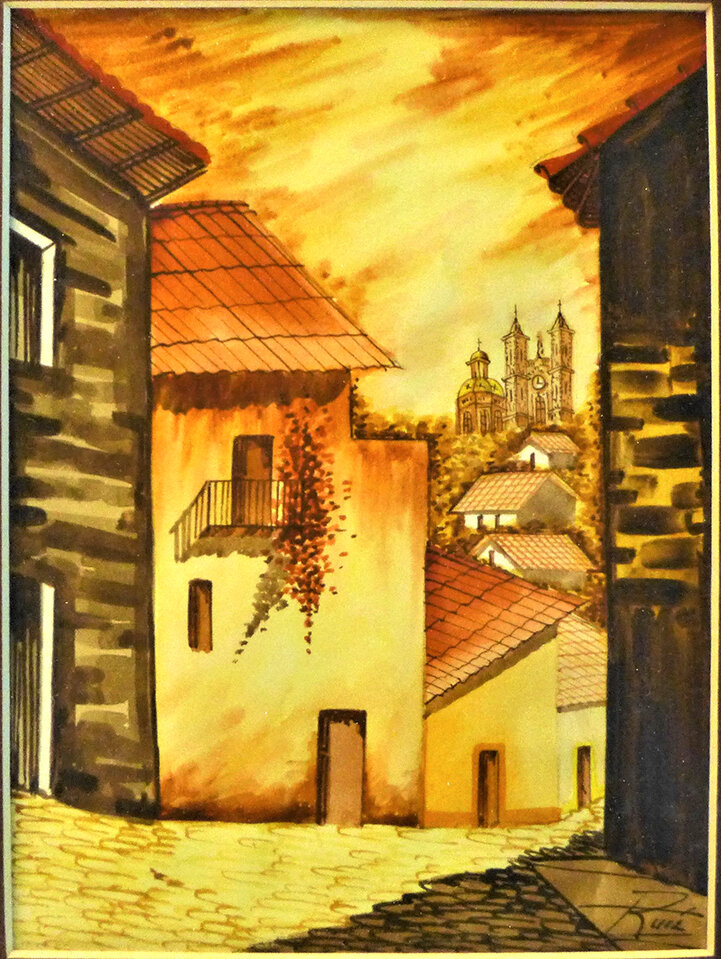Take a virtual tour
Curated by Matthew D. Davids, administrator of art collections
Curator’s statement
Watercolor paintings have been around for thousands of years, and the use of this ancient art medium has varied over time.
“Untitled (Mexican Town)” by Ruil
This exhibit consists of only artwork, but you can see watercolors in other aspects every day outside of art. You may be surprised to find watercolors in that old map you have stored in your closet, the illustrated guide on animals on your bookshelf, a postcard or some other item you may have. The next time you are out, or are going through some boxes, see if you can find anything that was created using watercolors.
The artwork shown in this exhibit displays a variety of styles and techniques, so take a look and see what you like best.
Questions to consider
What styles or techniques do you see in the exhibited artwork? What did you think of the use of the dry-brush technique?
Do you enjoy the artwork with less of the support — like the canvas — showing, or more?
Which style, technique or compositions do you enjoy the most? Do you want to try them yourself?
History, creation and impact of watercolors
History
“Untitled (Windmill with Fence)” by Brown Hudson
While watercolor has been used since Egyptian times for illustrations and art in manuscripts, some think it was used in some early European cave paintings. The use of watercolors in decoration developed around 4000 B.C. in Asia.
Watercolor became a more popular medium in Europe during the Renaissance starting in the 14th century, but it was not until the 18th century that watercolors started to influence the arts and culture scenes in Europe.
In America, artists in the 19th century began using watercolor painting for sketching and artwork studies as they prepared their canvases for oil and engraving. In the 18th century watercolor became established as a legitimate art medium for Europe, while in America, that happened later: The 19th and 20th centuries established watercolor as a successful medium in America.
Creation
“Leaving Confession” by Lowell Ellsworth Smith
Watercolor paint consists of a mixture of four main ingredients — a pigment, or color; a gum arabic that acts as a binder; evaporating water used to apply paint; and preservatives/additives like honey, whiskey, glycerin, etc., to strengthen, weaken or alter the paint pigment.
Traditionally, watercolor is painted on a support known as watercolor paper, which is partially or entirely, made of cotton. Other more exotic supports can include plastic, leatherwood, other fabrics and plastic.
There are several artist techniques used in watercolor artwork. Though the majority of techniques rely on how much water is used, a blue pigment will become lighter in color the more water is added, for example. Using a brush and pigment with little water is known as the dry-brush technique. This allows the artist to simulate a crayon drawing, making the painting seem granular. Another technique leaves the support structure like the canvas uncovered, allowing it to be seen through the watercolors.
Impact
The many social uses and advantages of watercolor contributed to the popularity and spread of watercolor painting in the 18th century, predominantly in Europe.
“Untitled (Flower with Geometric Elements)” by Olinka Hrdy
Aristocrats considered knowing how to properly use watercolors an important and desirable skill for their education.
With the popularity of watercolors rising, there was a surge in adjacent markets that catered not just to the arts but other fields as well, such as those for new brushes, hardier supports and instructional books.
Besides the arts, people used watercolor for things like military mapmaking; illustrating important monuments, ruins and historical events in archaeological or geographical expeditions; creating field guides and cataloguing animal or plant species and a myriad other uses. Those practices continue to this day.
Tag us on social media
Share your insight on social media with us by tagging @WigwamArt (Twitter) or using the hashtag #wigwamwatercolor.



